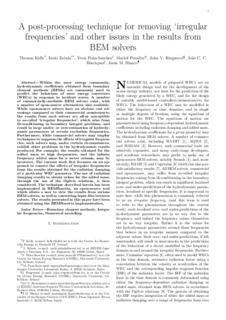Título
A post-processing technique for removing ‘irregular frequencies’ and other issues in the results from BEM solversAutor-a
Otras instituciones
Dundalk Institute of TechnologySENER (Spain)
National University of Ireland, Maynooth
Universidade de Lisboa
Universidad del País Vasco/Euskal Herriko Unibertsitatea (UPV/EHU)
Versión
Version publicada
Derechos
© 2022 The AuthorsAcceso
Acceso abiertoVersión del editor
https://doi.org/10.36688/imej.5.123-131Publicado en
International Marine Energy Journal Vol. 5. Nº 1. Pp. 123–131Primera página
123Última página
131Editor
European Wave and Tidal Energy ConferencePalabras clave
Boundary element methodsIrregular frequencies
Numerical modelling
Resumen
Within the wave energy community, hydrodynamic coefficients obtained from boundary element methods (BEMs) are commonly used to predict the behaviour of wave energy converters (WECs) in response to inc ... [+]
Within the wave energy community, hydrodynamic coefficients obtained from boundary element methods (BEMs) are commonly used to predict the behaviour of wave energy converters (WECs) in response to incident waves. A number of commercially-available BEM solvers exist, with a number of open-source alternatives also available. While open-source solvers have an obvious cost advantage compared to their commercial counterparts, the results from such solvers are often susceptible to so-called ‘irregular frequencies’, which arise from ill-conditioning in boundary integral problems, and result in large under- or over-estimation of hydrodynamic parameters at certain excitation frequencies. Furthermore, while commercial solvers may employ techniques to suppress the effects of irregular frequencies, such solvers may, under certain circumstances, exhibit other problems in the hydrodynamic results produced. For example, the results obtained for the added mass at high frequencies, and the infinite frequency added mass for a water column, may be incorrect. The current work first focusses on an approach to remove the effects of irregular frequencies from the results obtained for the radiation damping of a particular WEC geometry. The use of radiation damping results to obtain values for the added mass, through the use of the Ogilvie relations, is then considered.
The technique described herein has been implemented in BEMRosetta, an open-source tool which allows a user to view the results from various BEM solvers, as well as converting input files between solvers. The results presented in this paper have been obtained using the BEMRosetta implementation. [-]
Colecciones
- Artículos - Ingeniería [730]
El ítem tiene asociados los siguientes ficheros de licencia:























